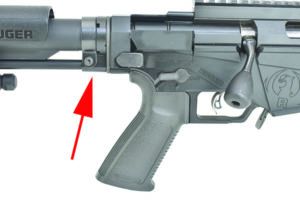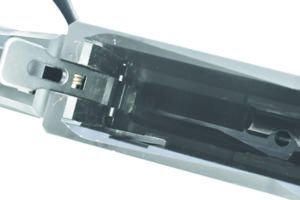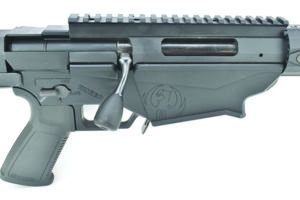Gun Tests Grade: B+
$1599
Ruger introduced its Precision Rifle in the summer of 2015, and it instantly became a hit. They were a very hard commodity to find for at least the first two years after introduction. With demand the way it is during the current Covid panic, they are once again difficult to obtain. Why, you ask? It is a good product at a reasonable price. We have seen many accurate rifles. Any number of those were designed for long-range shooting. It is that “reasonable price” thing that took a while for people to figure out.
| Action Type | Bolt |
| Action | Matte-black steel |
| Overall Length | Adjustable |
| Weight Unloaded | 11.2 lbs. |
| Weight Loaded (108 grain, 4 rounds) | 11.8 lbs. |
| Overall Height w/o Scope Mount | 7.3 in. |
| Barrel | 24 in. long, 1:7.7 in. twist, matte-black steel |
| Sight Radius | NA |
| Magazine Type | Detachable box |
| Magazine Capacity | 10 |
| Stock | Adjustable polymer & steel chassis |
| Stock Drop at Comb | Adjustable |
| Stock Drop at Heel | Adjustable |
| Stock Bedding | NA |
| Stock Buttplate | Rubber |
| Stock Length of Pull | Adjustable |
| Receiver Scope-Base Pattern | Integral 20 MOA pic rail, |
| #8-40 screws | |
| Trigger Pull Weight | 1.9 lbs. |
| Safety | Ambidextrous thumb |
| Warranty | None written |
| Telephone | (336) 949-5200 |
| Website | Ruger.com |
| Made In | USA — New Hampshire |

Because recoil management is such an important part of PRS shooting (if you can see your miss, you can correct for it on the follow-up shot), Ruger designed its rifle to allow recoil to be transmitted in a straight line back to the shooter’s shoulder via use of an in-line stock. Barrel, action, check rest, and shoulder stock are almost all on a straight line, thus reducing muzzle jump a bit. The Ruger buttstock can be interchanged with most AR-15 compatible stocks, as can several other parts, such as the pistol grip and forend. That translates to an enormous number of options available to shooters as they tailor the rifle to themselves. Adjustments to length of pull and cheek height are made by the lifting of levers, changing the length as desired and then locking the levers back down. The stock is hinged and folds to the left. It has a QD attachment, a soft-rubber buttpad, and it also provides a bottom Picatinny rail allowing for the attachment of a monopod or just a good, flat surface for riding on a bag.
The upper receiver is CNC machined from pre-hardened 4140 chrome-moly steel. The one-piece bolt is also 4140 steel and is configured with three lugs to allow a 70-degree bolt throw. Add in the dual cocking cams along with a nitrided bolt body, and you get a bolt assembly that is corrosion resistant and runs smoothly. The upper comes with a 20-MOA Picatinny rail attached via #8-40 screws. The lower is 7075-T6 aluminum that has been Type III black hard-coat anodized. The rifle comes with a 10-round Magpul plastic magazine but, luckily, the magazine catch has been designed so that most AICS-pattern magazines will also work. The magwell is designed so that the lip protrudes forward from the opening so that it can serve as a barricade stop. This helps prevent the shooter from jamming the magazine into a support bag or barricade that could cause a malfunction. The magazine is released by a paddle located immediately in front of the trigger guard in a location easily operated by either hand.

Disassembly is simple. Make sure the rifle is unloaded, then do it again. Close the bolt, then depress the latch on the left side of the receiver at the rear. The stock will hinge open to the left. The bolt can then be opened, and, when the bolt latch on side of the action has been depressed, the bolt can be removed. The owner’s manual carries full instructions on how to disassemble the receiver. That takes a bit more time.

A Ruger Marksman Adjustable trigger is standard equipment. It is externally adjusted via a wrench stored in the bolt shroud with a trigger-pull range from 2.25 to 5 pounds, according to Ruger literature. Ours was a bit lighter, averaging 1.9 pounds, and was very consistent, averaging only 1.5 ounces standard deviation on the pull weights. We like light. We also like crisp. Through the testing of several RPRs through the years (including this one), we have found it common to have a rifle with a trigger we can actually feel flex a bit as we press it to the rear. Is this a deal breaker? No. But we prefer triggers, especially on precision rifles, that have little to no movement prior to release.
The barrel is a chrome-moly 24-inch medium-contour cold-hammer-forged tube with 5R rifling. Head space is set at a minimum, as is runout (the chamber is nicely centered in the barrel). Unlike some others on the market, this barrel is easily replaced by a competent gunsmith with good headspace gauges. It features a Ruger Precision Hybrid Muzzle Brake to help hold recoil and muzzle jump to a minimum. Thread on the brake is 5⁄8×24 as would be expected. The 15-inch free-floating handguard is also black, hard-coat anodized aluminum and features Magpul M-Lok slots on all four sides. The handguard is also easily exchanged with AR-15 spec parts, and we would probably change it out. The shape is octagonal with the lower bearing surface (which you would rest upon some kind of bag) measuring only a bit more than 0.6 inch wide. We would love to see a larger, flat surface for the bottom.
The RPR came in third place in the accuracy testing, with an average five-shot group size of 0.79 inch across five different types of ammunition, none of which were tailored to the rifle. Not too shabby. Those kinds of groups will certainly get a shooter started in PRS. Our RPR preferred the Berger factory loads using the 105-grain Hybrid target bullets. This was the favorite load for three of the four rifles. The Savage liked the Black Hills 108-grain ELD-M best.
Our Team Said: The RPR had the fastest times in our field trials. It also had the lowest scores. We were trying to push our times to the failure point (where we would start missing), and it appears we went a bit faster than the RPR was ready for us to go. We would also like to see this rifle with more weight on the front end. The balance point was a bit too far to the rear.
6MM CREEDMOOR Range Data
| 6MM CREEDMOOR Range Data | |||||
| Black Hills 103-grain ELD-X | Ruger Precision Rifle | Savage 110 Elite | Christensen MPR | Masterpiece Arms PMR Pro | |
| Average Velocity | 2819 fps | 2935 fps | 2899 fps | 2839 fps | |
| Muzzle Energy | 1907 ft.-lbs. | 1971 ft.-lbs. | 1923 ft.-lbs. | 1844 ft.-lbs. | |
| Best Group | 0.62 in. | 0.44 in. | 0.59 in. | 0.61 in. | |
| Average Group | 0.75 in. | 0.73 in. | 0.75 in. | 0.79 in. | |
| Black Hills 108-grain ELD-M | Ruger Precision Rifle | Savage 110 Elite | Christensen MPR | Masterpiece Arms PMR Pro | |
| Average Velocity | 2730 fps | 2875 fps | 2890 fps | 2922 fps | |
| Muzzle Energy | 1705 ft.-lbs. | 1983 ft.-lbs. | 2004 ft.-lbs. | 2049 ft.-lbs. | |
| Best Group | 0.55 in. | 0.54 in. | 0.66 in. | 0.64 in. | |
| Average Group | 0.75 in. | 0.66 in. | 0.89 in. | 0.83 in. | |
| Berger 105-grain HT | Ruger Precision Rifle | Savage 110 Elite | Christensen MPR | Masterpiece Arms PMR Pro | |
| Average Velocity | 2830 fps | 2934 fps | 2891 fps | 2926 fps | |
| Muzzle Energy | 1867 ft.-lbs. | 2008 ft.-lbs. | 1949 ft.-lbs. | 1997 ft.-lbs. | |
| Best Group | 0.58 in. | 0.65 in. | 0.40 in. | 0.35 in. | |
| Average Group | 0.67 in. | 0.72 in. | 0.50 in. | 0.61 in. | |
| Federal 105-grain OTM | Ruger Precision Rifle | Savage 110 Elite | Christensen MPR | Masterpiece Arms PMR Pro | |
| Average Velocity | 3056 fps | 3146 fps | 3129 fps | 3160 fps | |
| Muzzle Energy | 2179 ft.-lbs. | 2308 ft.-lbs. | 2284 ft.-lbs. | 2329 ft.-lbs. | |
| Best Group | 0.78 in. | 1.27 in. | 0.77 in. | 0.56 in. | |
| Average Group | 0.86 in. | 1.46 in. | 1.00 in. | 0.76 in. | |
| Black Federal 107-grain SMK | Ruger Precision Rifle | Savage 110 Elite | Christensen MPR | Masterpiece Arms PMR Pro | |
| Average Velocity | 2959 fps | 3049 fps | 3022 fps | 3058 fps | |
| Muzzle Energy | 2081 ft.-lbs. | 2209 ft.-lbs. | 2171 ft.-lbs. | 2222 ft.-lbs. | |
| Best Group | 0.69 in. | 0.87 in. | 0.52 in. | 0.59 in. | |
| Average Group | 0.94 in. | 0.96 in. | 0.53 in. | 0.66 in. |

























